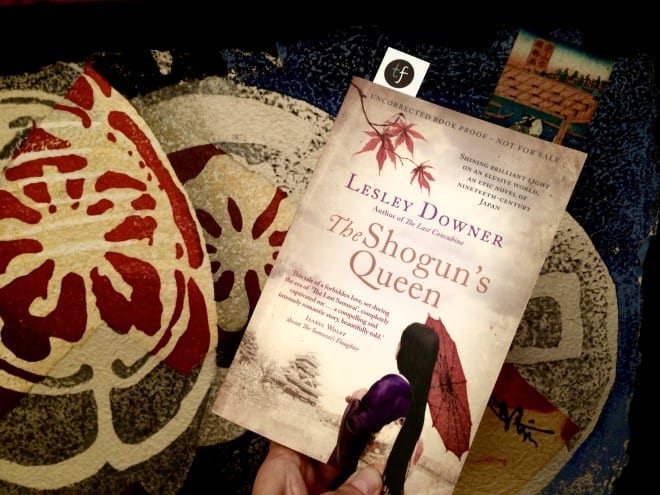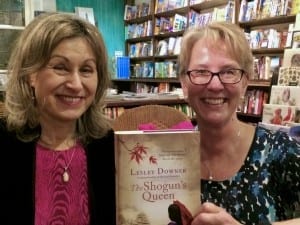Psychological thriller set in Berlin
Novel set in Japan
5th November 2016
The Shogun’s Queen, by Lesley Downer, novel set in Japan of the 1850s.
This is the fictionalised story from the women’s perspective of the latter years rule of the Tokugawa shogunate. It was a period of stability, economic prosperity, cultural blossoming, with a strict social and hierarchical order. Japan also had had an isolationist policy, which left the Japanese wholly unprepared for the advancing westerners, who had already subjugated India and vast swathes of China and now had their sights set on this string of islands. There may have been one Shogun at the head of the country, based in Edo (the Tokyo of today) but he ruled over the daimyō, the local lords, and one of the issues threaded throughout the story are the efforts to bring all the disparate units together, so that Japan could present a unified front to the powerful forces descending.
 Okatsu, called Atsu, is a young woman from the backwaters of Satsuma. She clearly has qualities that will take her far, and she is given as a daughter to Lord Nariakira, a seemingly caring paternal figure, yet an arch political manipulator. But political intrigue was intrinsic to court dynamics and both women and men formulated their goals and plotted and schemed their way forward, and Atsu found herself projected into the heart of political manoeuvring.
Okatsu, called Atsu, is a young woman from the backwaters of Satsuma. She clearly has qualities that will take her far, and she is given as a daughter to Lord Nariakira, a seemingly caring paternal figure, yet an arch political manipulator. But political intrigue was intrinsic to court dynamics and both women and men formulated their goals and plotted and schemed their way forward, and Atsu found herself projected into the heart of political manoeuvring.
Atsu is then groomed to become the wife of the current Shogun, Tokugawa Iesada, who had outlived two wives already. It is a strategic match engineered by Lord Nariakira to secure his choice of heir, as Iesada has no heir and it is imperative to have strong and secure leadership at a period when the West is showing great interest in trading with Japan. If that can’t be done peacefully, then the foreigners are quite clear that they will resort to arms. Japan has until this point been so inward-looking that the might of the sabre-rattling Westerners is an anathema and many of the factions within the country have little understanding of how to approach the situation. Strong leadership is required!

At the Book Launch of The Shogun’s Queen
But Iesada is already in thrall to his Mother and thus Atsu not only has to negotiate her way to the Shogun’s heart, so that she can implement Nariakira’s plan, but she also has to handle her wily mother-in-law. Atsu is a clever strategist pulling strings behind the scenes of a Shogunate that is nearing the end of its reign. “A clever woman never lets a man know how clever she is“…indeed.
This is a beautifully told story, rich in period detail and a must read if you are visiting Japan. I have visited many of the grand buildings in Kyoto, Nara and Tokyo, and was charmed to add to my understanding through the narrative crafted in this novel. I could imagine the characters in their sumptuous robes gliding along the wooden corridors, I could visualise the beautiful vistas across the palace gardens. I have even stepped on a nightingale floor in Kyoto – in Japanese “uguisubari” – described in the novel, a security device to alert the inhabitants to any intruders.
I was driven to research a little more about the fashion phenomenon of blackened teeth amongst the women of the period, which again is described in the book: apparently it is called Ohaguro, and the look is achieved by dissolving iron filings in vinegar, then combined with tea or gallnut powder, which made it non-water-soluble. It would be applied perhaps once a day and protected the teeth from decay.
A wonderfully written novel, that has been meticulously researched and was an absolute pleasure to read. It transported me to the period and place and has remained with me since I read it.
Tina for the TripFiction Team
Over to Lesley who is joining us for a #TalkingLocationWith… feature
“Travelling through Japan in the footsteps of Atsu to research The Shogun’s Queen”.
Hello, Tina. First, thank you for inviting me to post on TripFiction today. I much appreciate it!
For me researching a book always involves travel. Even when I’m writing fiction the sense of place is always fundamental, perhaps because I began by writing travel books and am still a travel writer – or perhaps it’s that I just love travel.
Each book in The Shogun Quartet has enabled me to explore a different part of Japan and get deeply into different aspects of its history. The Last Concubine took me to the Nakasendo, the Inner Mountain Way that winds along the valleys of central Japan, and to Mount Akagi, where the shogun’s lost gold is supposedly buried somewhere. (And no, I didn’t manage to find it). For The Courtesan and the Samurai I went to Hakodate, on Japan’s northernmost island, Hokkaido, and stomped through deep snow to visit the sites where the last great battle of Japan’s civil war was fought. I also discovered and fell in love with Victorian-era sail and steam ships. And The Samurai’s Daughter took me to the northern city of Aizu Wakamatsu very near Fukushima, not long after the terrible earthquake and tsunami.
My latest historical novel, The Shogun’s Queen, is based very closely on fact. Atsu’s story is so powerful I really wanted to tell it and to bring her and the places which she knew alive.
Atsu grew up in the idyllic seaside and spa resort of Ibusuki and spent the first seventeen years of her life there. It’s a tropical place at the far tip of the southern island of Kyushu. You can see Mount Kamon not far away, a fairy-tale cone-shaped mountain even more perfect than Mount Fuji. Instead of taking the waters there, you’re buried in hot black mineral sands. We put on cotton gowns called yukatas and lay in trenches with a little pillow to support our heads while grizzled old men shovelled hot sand over us till we were completely buried apart from our faces. It’s surprisingly heavy and hot like a blanket and supposedly incredibly good for you.
I saw the beach and the ocean and the palm trees and got some feeling of this beautiful place where Atsu spent her childhood and expected to live her whole life. But fate had other plans for her.

The author in a palanquin, see how small it is!
From there Atsu went to Kagoshima, the capital of the province. She travelled by palanquin; in those days you walked or, if you were grand enough, were carried on the shoulders of muscular bearers. We went by car. Kagoshima is another tropical paradise. The great volcanic cone of Sakurajima looms over the city and the bay, perpetually belching black ash. You can see fire spouting out of the crater at night. The town is dusted with ash and gritty underfoot and on some days you have to carry an umbrella; and occasionally the volcano erupts. We stayed in a hot spring resort right on its slopes. These days most spa resorts have separate baths for men and women, ever since prudish Victorian travellers arrived to spoil the fun, but this one is mixed. We wore white yukatas and reclined up to our necks in hot mineral waters, gazing at the sea and the sky.

Sakurajima volcano
Atsu was taken to live in Kagoshima Castle, the seat of her uncle, Lord Nariakira. The moat and building and vast grounds are still there directly under the lea of the hill. Lord Nariakira was a brilliant man, way ahead of his time. Under the cliffs down by the bay he had a secret factory complex turning out glass, cannons and daguerreotype photographs. There was even a ship building yard, which came in very handy when the British and Americans turned up and decided to attack. The solid stone buildings are still there, alongside the exquisite gardens and delicate wooden tracery of his summer villa.
But that was far from the end of Atsu’s journey – or mine. From there she travelled (by palanquin, of course) across Kyushu to the main island, Honshu, and along what was the major highway of the time. It took her six weeks. By bullet train it took us a day. Atsu stopped in Kyoto and I too had my own reasons to stop there.
I knew that in Edo, now known as Tokyo, she had entered the Women’s Palace, a kind of harem of three thousand women where the only man who could enter was the shogun. I wanted to imagine myself back in Atsu’s time, to imagine the sort of environment where she lived.

Nijo Castle
 In Kyoto I went to Nijo Castle and spent a long time in the Women’s Palace there. In the guidebook it’s called rather primly the shogun’s private quarters which is true – except that it was populated entirely by women. While the walls of the men’s palace are covered with lavish designs of pine trees and tigers painted on gold leaf screens, the women’s palace is much more restrained and tranquil in decor, with sliding doors etched with delicate ink paintings of Chinese landscapes. As I walked in stocking feet around the long dark corridors past the heavy wooden pillars and beams, I tried to imagine myself back in that world of women.
In Kyoto I went to Nijo Castle and spent a long time in the Women’s Palace there. In the guidebook it’s called rather primly the shogun’s private quarters which is true – except that it was populated entirely by women. While the walls of the men’s palace are covered with lavish designs of pine trees and tigers painted on gold leaf screens, the women’s palace is much more restrained and tranquil in decor, with sliding doors etched with delicate ink paintings of Chinese landscapes. As I walked in stocking feet around the long dark corridors past the heavy wooden pillars and beams, I tried to imagine myself back in that world of women.
And finally Atsu and I reached our destination – called Edo in her day, Tokyo in mine. As to what became of her there, you’ll have to read The Shogun’s Queen to find out.
Thank you so much to Lesley, it has been fascinating to learn a little more about the background research.
You can follow Lesley on Twitter, Facebook and via her website.
And do come and connect with Team TripFiction via Twitter (@tripfiction), Facebook (TripFiction), Instagram (TripFiction) and Pinterest (TripFiction)… and now YouTube
For more books set in JAPAN just click here.

 Please wait...
Please wait...

Wish I’d had the chance to visit some of these places but every trip I took to Japan I was stuck in Tokyo.
Just back from a trip to Japan myself and now itching to return! The level of detailed research you’ve put into the background of your books is a story in itself, each region so contrasting and strange.